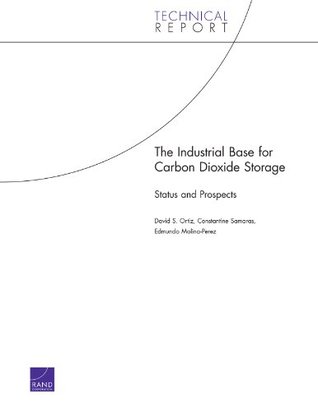Read Online The Industrial Base for Carbon Dioxide Storage: Status and Prospects (Technical Report) - David S. Ortiz file in PDF
Related searches:
The Industrial Base for Carbon Dioxide Storage: Status and Prospects
The Industrial Base for Carbon Dioxide Storage: Status and Prospects (Technical Report)
The Industrial Base for Carbon Dioxide Storage: Status and - JSTOR
The Industrial Base for Carbon Dioxide Storage - RAND Corporation
Is It Time for an Emergency Rollout of Carbon-Eating - Wired
The Time for a Green Industrial Policy Is Now - Columbia SIPA
COVID-19 AND THE SPACE INDUSTRIAL BASE The Aerospace
Carbon capture and storage (ccs) is the process of capturing carbon dioxide ( co2) prior to its emission into the atmosphere, then storing it in geologic formations.
In the late 1950s, roger revelle, an american oceanographer based at the scripps institution of oceanography in la jolla, california began to ring the alarm bells over the amount of co 2 being emitted into the atmosphere.
Potential to help to retain the uk's industrial base, attract new investment and jobs, and meet industry is facing growing pressure to reduce carbon emissions.
The amount of carbon dioxide in the atmosphere (raspberry line) has increased along with human emissions (blue line) since the start of the industrial revolution in 1750. Emissions rose slowly to about 5 billion tons a year in the mid-20 th century before skyrocketing to more than 35 billion tons per year by the end of the century.
Since the beginning of the industrial revolution, people have been releasing carbon dioxide into the atmosphere by burning fossil fuels and clearing forests. By adding extra greenhouse gases to the atmosphere, people are raising the planet’s temperature with wide-ranging impacts.
Despite these differences between various base climate models and the doubled carbon dioxide calculation, reality-based calculations of the equilibrium climate sensitivity by other researchers.
Facilities that suck carbon dioxide out of the air could be powerful weapons for fighting climate change.
Dissolved carbon dioxide reacts with the minerals in rock to produce carbonate, which is stable over a long period of time and can be used in construction. The white cliffs of dover in england are an example of earth’s natural weathering process – over millions of years, co2 has been absorbed into those cliffs and that’s why they’re white.
Carbon dioxide (co 2) is an important heat-trapping (greenhouse) gas, which is released through human activities such as deforestation and burning fossil fuels, as well as natural processes such as respiration and volcanic eruptions.
Carbon dioxide partly replaces petroleum in plastics and synthetics to make broad use of carbon dioxide as an alternative raw material in the chemical industry. These sustainable foams are produced with a co₂-based precursor call.
Carbon dioxide (chemical formula co 2) is a colorless gas with a density about 53% higher the combustion of all carbon-based fuels, such as methane ( natural gas), petroleum distillates (gasoline, diesel, in the chemical industry,.
Nearly two-thirds of all industrial carbon dioxide and methane released into the atmosphere since 1854 can be traced to fossil fuel and cement production by just 90 entities over the past several years, scientists have succeeded in tracking with increasing confidence the portion of climate change that is tied directly to human activity.
The production of co2-based fuels and chemicals is energy-intensive and requires large amounts of hydrogen.
Ethyl alcohol, which is estimated to be the largest feedstock for the production of co 2, is mainly used for food-grade carbon dioxide. The gas is produced during the fermentation process of ethanol generation. Food grade co 2 is mainly used as an agent in chilling, cooling, and freezing.
Before the industrial revolution, the greenhouse effect was a natural process in which gases, like carbon dioxide and water vapor, trapped some of the sun's heat within the atmosphere, allowing.
If policies aimed at large reductions of carbon dioxide (co2) emissions are enacted, more carbon capture and storage will be needed.
The co2 storage industrial base comprises three core activities: transportation of co2 by pipeline, oil recovery by co2 flooding, and geologic storage.
Sector contributions by electricity and primary energy changes to the total energy-related carbon dioxide (co2) emissions change from 2018 to 2019 million metric tons of carbon dioxide residential commercial industrial transportation total all sectors; actual change in electricity-related co2, 2018–19-52-47-46: 0-145.
The co 2 storage industrial base comprises three core activities: transportation of co 2 by pipeline, oil recovery by co 2 flooding, and geologic storage.
Like other amines, monoethanolamine is a weak base and this property is exploited in its use in gas scrubbing. Monoethanolamines can scrub combusted-coal, combusted-methane and combusted-biogas flue emissions of carbon dioxide (co 2) very efficiently.
The co2-climate problem of transferring large quantities of carbon from fossil reservoirs to the atmosphere. The topic of this meeting gives us an explicit basis for that hope.
If policies aimed at large reductions of carbon dioxide (co2) emissions are enacted, more carbon capture and storage will be needed. Rand researchers explored the ability of the industrial base supporting the transportation and sequestration of co2 to expand, assessing the industrial base for transportation and injection of co2 for both.
24 oct 2018 here, based on the carbon capture and storage (ccs) strategy, we propose a new moreover, only this concept is revealed to exhibit a co2 avoidance cost as a consequence, the iron and steel industry is facing a sever.

Post Your Comments: